Abstract
OBJECTIVE--To analyse the relation between fibrinogen concentration and social class and other social factors found to be related to mortality. The results regarding cardiovascular disease are unpublished, as yet. DESIGN--Cross sectional population study. SETTING--City of Gothenburg, Sweden. SUBJECTS--639 Men from a population sample of 1016 men aged 50 in 1983. They were all employed and had no history of myocardial infarction or stroke. Fibrinogen values were available for all of them. MAIN OUTCOME MEASURE--Fibrinogen concentration in relation to socioeconomic state according to occupation, and other social influences determined as number of people in the household and scores of social activities and activities in and outside the house. RESULTS--Men with low scores for activities at home had a mean plasma fibrinogen concentration of 3.34 g/l (95% confidence interval 3.21 to 3.47), whereas those with an intermediate score had a mean concentration of 3.16 (3.00 to 3.32) g/l and those with a high score 3.02 (2.95 to 3.10) g/l. Similar inverse relations were noted for the two other activity scores and for occupational class (class 1 being unskilled and semiskilled workers and class 5 professionals and executives) and the number of people in the household. Smoking exerted a strong influence on fibrinogen concentration, the relations between fibrinogen concentration and social factors being evident only in non-smokers. The mean difference in fibrinogen value between the non-smokers with the lowest activity scores at home and those with the highest scores was 0.36 (0.19 to 0.54) g/l, and similar differences were seen for the two other activity scores. Multiple regression analyses showed smoking, body mass index, the sum of all activities (inverse relation), and diabetes to be independently associated with fibrinogen value, whereas occupational class (p = 0.81) and the number of people in the household (p = 0.09) were not. CONCLUSIONS--Psychosocial influences seem to influence the coagulation system in the body in a way that is associated with cardiovascular disease and premature death.
Full text
PDF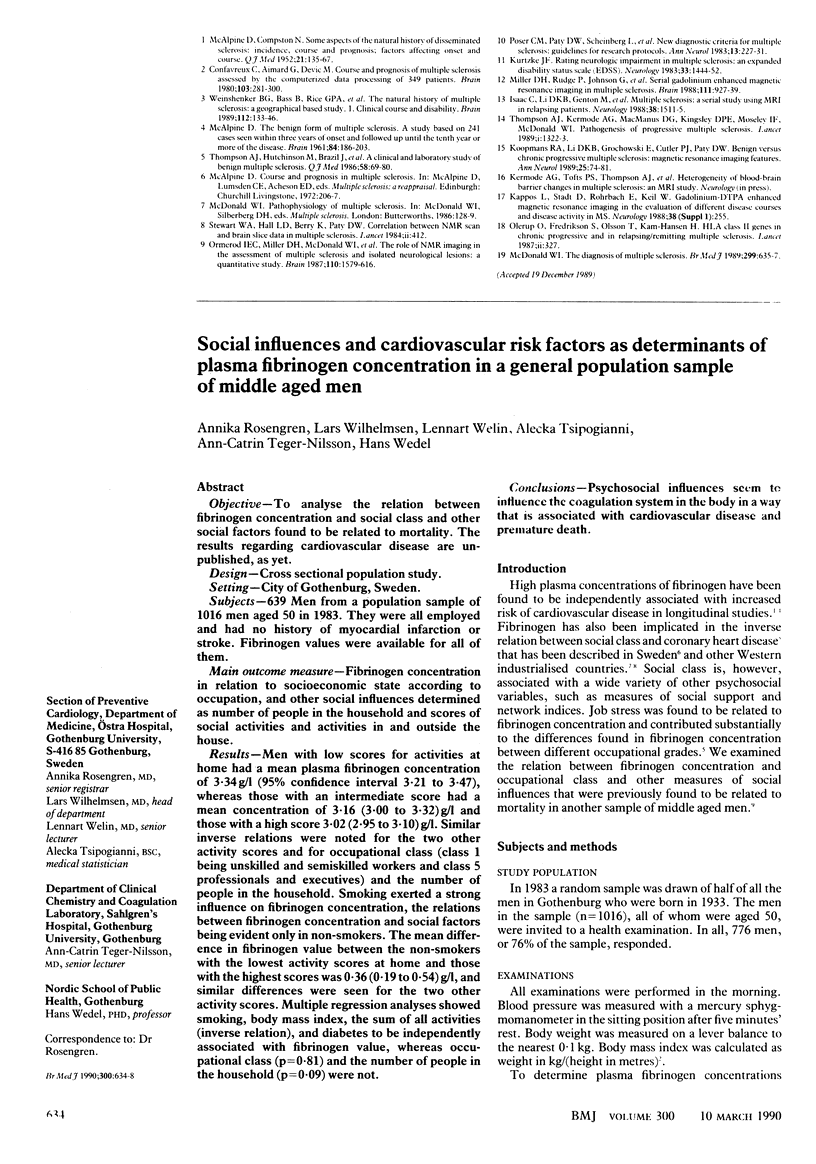
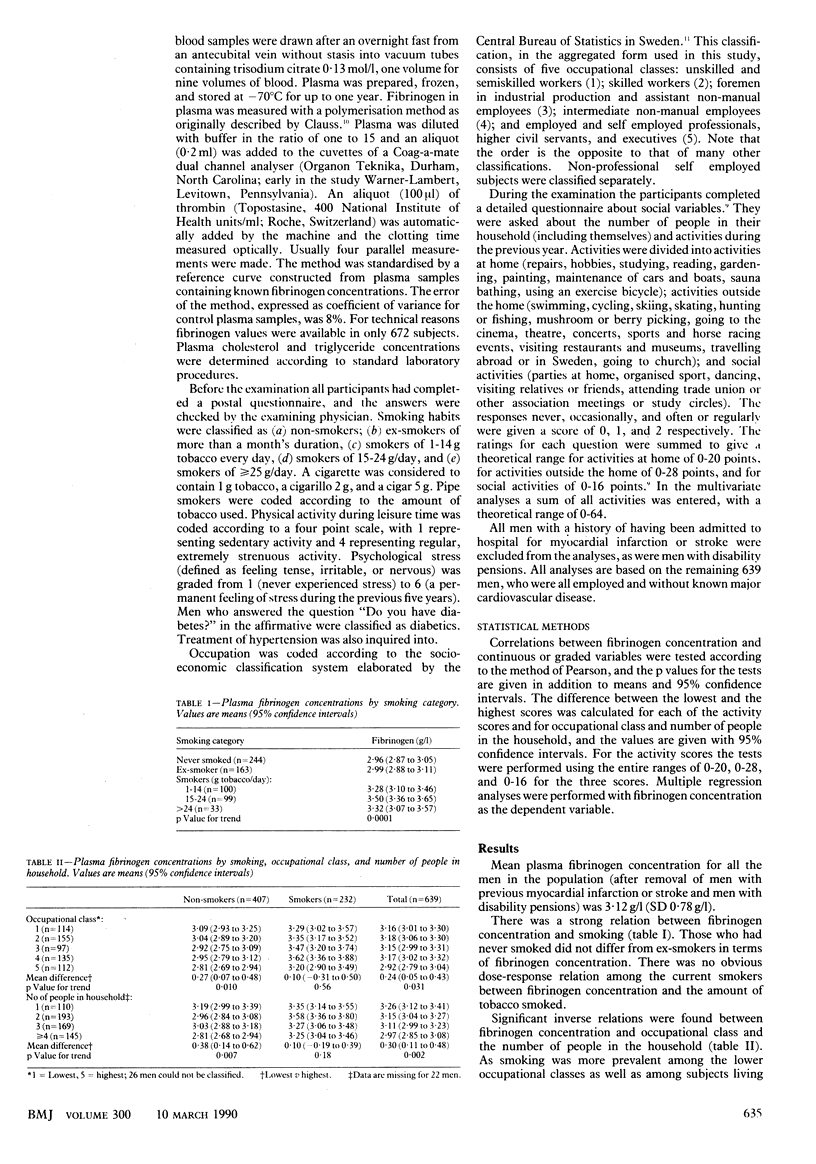
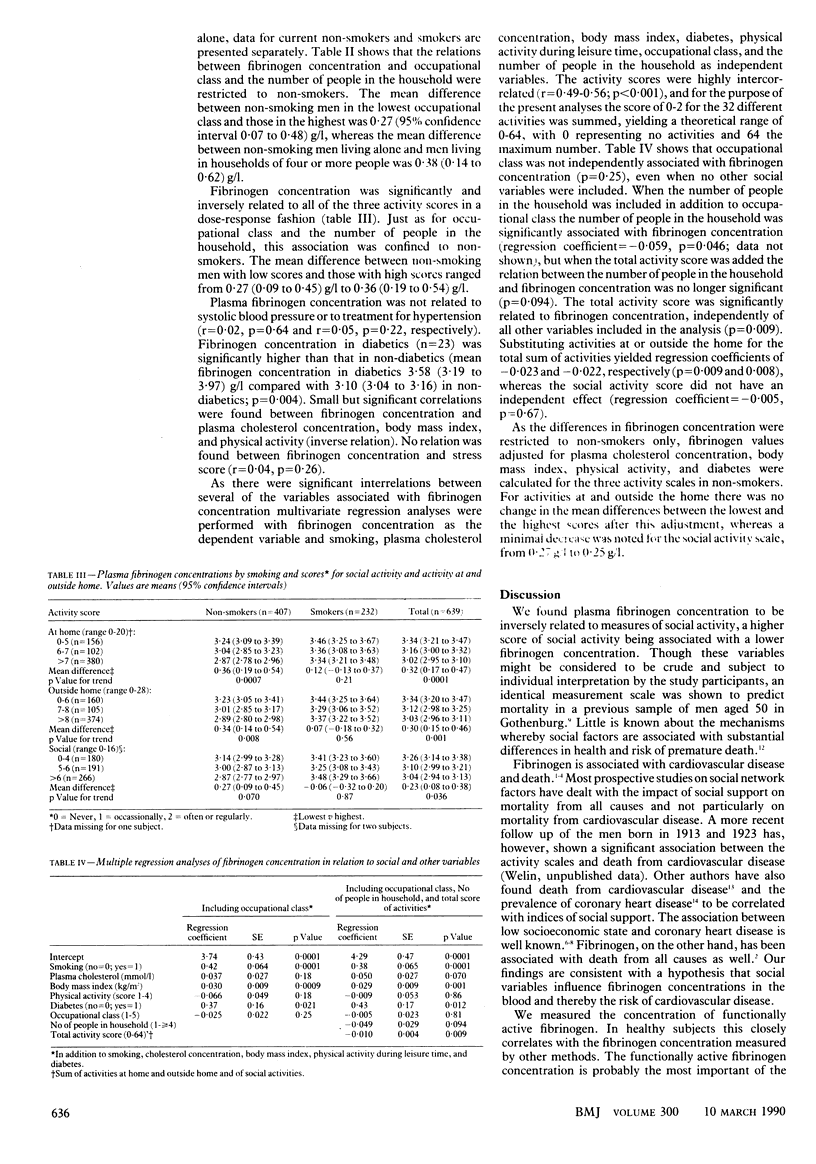
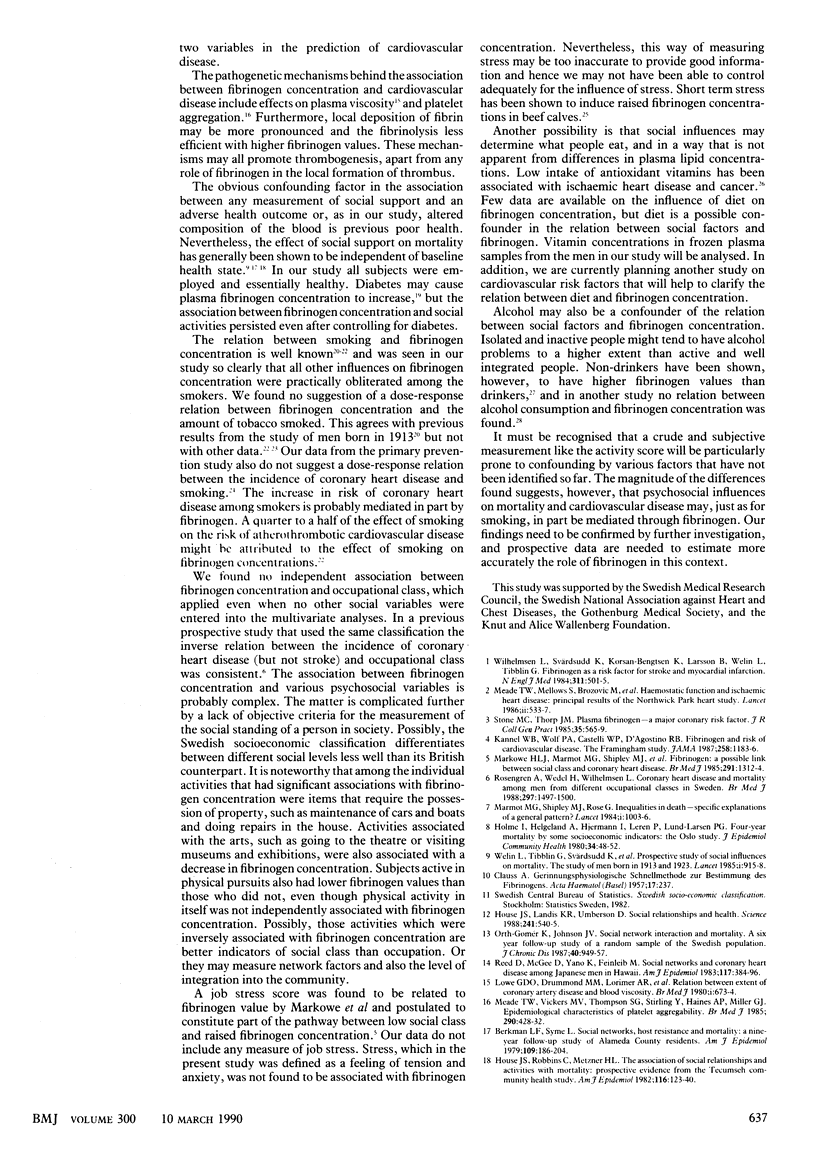
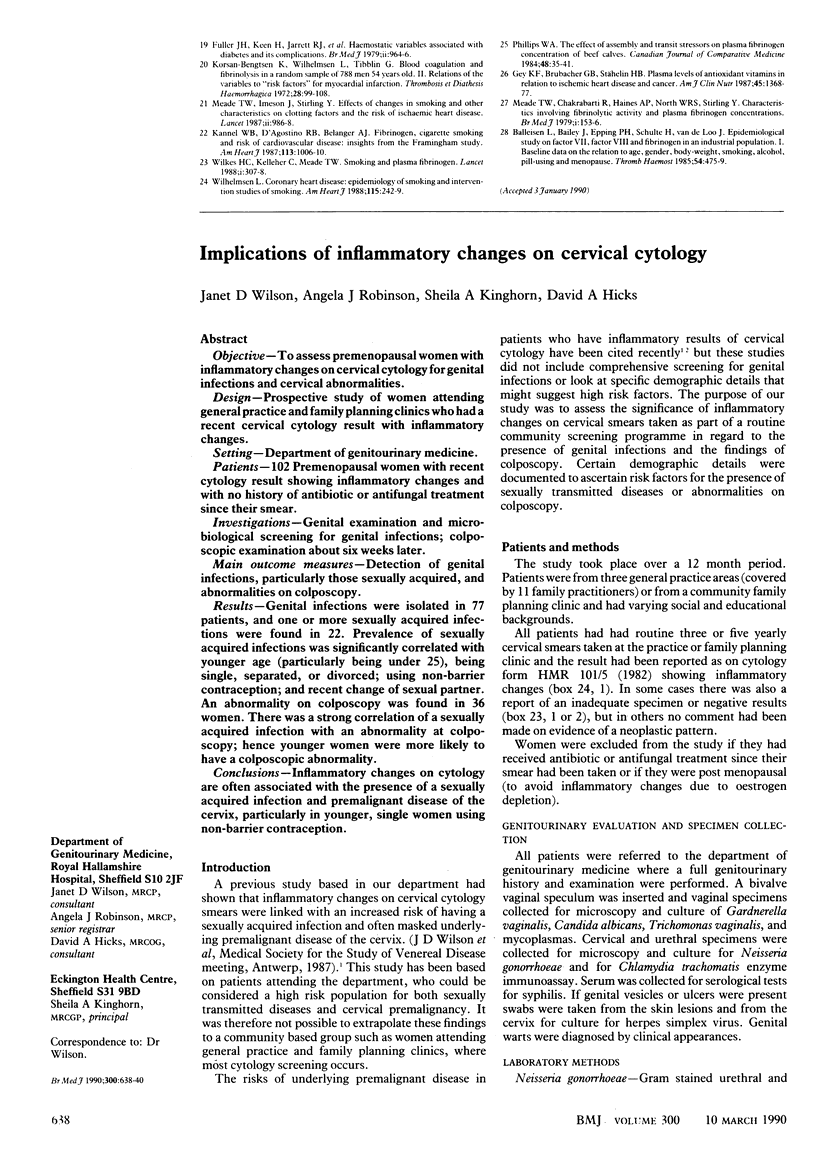
Selected References
These references are in PubMed. This may not be the complete list of references from this article.
- Balleisen L., Bailey J., Epping P. H., Schulte H., van de Loo J. Epidemiological study on factor VII, factor VIII and fibrinogen in an industrial population: I. Baseline data on the relation to age, gender, body-weight, smoking, alcohol, pill-using, and menopause. Thromb Haemost. 1985 Aug 30;54(2):475–479. [PubMed] [Google Scholar]
- Berkman L. F., Syme S. L. Social networks, host resistance, and mortality: a nine-year follow-up study of Alameda County residents. Am J Epidemiol. 1979 Feb;109(2):186–204. doi: 10.1093/oxfordjournals.aje.a112674. [DOI] [PubMed] [Google Scholar]
- CLAUSS A. Gerinnungsphysiologische Schnellmethode zur Bestimmung des Fibrinogens. Acta Haematol. 1957 Apr;17(4):237–246. doi: 10.1159/000205234. [DOI] [PubMed] [Google Scholar]
- Fuller J. H., Keen H., Jarrett R. J., Omer T., Meade T. W., Chakrabarti R., North W. R., Stirling Y. Haemostatic variables associated with diabetes and its complications. Br Med J. 1979 Oct 20;2(6196):964–966. doi: 10.1136/bmj.2.6196.964. [DOI] [PMC free article] [PubMed] [Google Scholar]
- Gey K. F., Brubacher G. B., Stähelin H. B. Plasma levels of antioxidant vitamins in relation to ischemic heart disease and cancer. Am J Clin Nutr. 1987 May;45(5 Suppl):1368–1377. doi: 10.1093/ajcn/45.5.1368. [DOI] [PubMed] [Google Scholar]
- Holme I., Helgeland A., Hjermann I., Leren P., Lund-Larsen P. G. Four-year mortality by some socioeconomic indicators: the Oslo study. J Epidemiol Community Health. 1980 Mar;34(1):48–52. doi: 10.1136/jech.34.1.48. [DOI] [PMC free article] [PubMed] [Google Scholar]
- House J. S., Landis K. R., Umberson D. Social relationships and health. Science. 1988 Jul 29;241(4865):540–545. doi: 10.1126/science.3399889. [DOI] [PubMed] [Google Scholar]
- House J. S., Robbins C., Metzner H. L. The association of social relationships and activities with mortality: prospective evidence from the Tecumseh Community Health Study. Am J Epidemiol. 1982 Jul;116(1):123–140. doi: 10.1093/oxfordjournals.aje.a113387. [DOI] [PubMed] [Google Scholar]
- Kannel W. B., D'Agostino R. B., Belanger A. J. Fibrinogen, cigarette smoking, and risk of cardiovascular disease: insights from the Framingham Study. Am Heart J. 1987 Apr;113(4):1006–1010. doi: 10.1016/0002-8703(87)90063-9. [DOI] [PubMed] [Google Scholar]
- Kannel W. B., Wolf P. A., Castelli W. P., D'Agostino R. B. Fibrinogen and risk of cardiovascular disease. The Framingham Study. JAMA. 1987 Sep 4;258(9):1183–1186. [PubMed] [Google Scholar]
- Korsan-Bengtsen K., Wilhelmsen L., Tibblin G. Blood coagulation and fibrinolysis in a random sample of 788 men 54 years old. II. Relations of the variables to "risk factors" for myocardial infarction. Thromb Diath Haemorrh. 1972 Aug 31;28(1):99–108. [PubMed] [Google Scholar]
- Markowe H. L., Marmot M. G., Shipley M. J., Bulpitt C. J., Meade T. W., Stirling Y., Vickers M. V., Semmence A. Fibrinogen: a possible link between social class and coronary heart disease. Br Med J (Clin Res Ed) 1985 Nov 9;291(6505):1312–1314. doi: 10.1136/bmj.291.6505.1312. [DOI] [PMC free article] [PubMed] [Google Scholar]
- Marmot M. G., Shipley M. J., Rose G. Inequalities in death--specific explanations of a general pattern? Lancet. 1984 May 5;1(8384):1003–1006. doi: 10.1016/s0140-6736(84)92337-7. [DOI] [PubMed] [Google Scholar]
- Meade T. W., Chakrabarti R., Haines A. P., North W. R., Stirling Y. Characteristics affecting fibrinolytic activity and plasma fibrinogen concentrations. Br Med J. 1979 Jan 20;1(6157):153–156. doi: 10.1136/bmj.1.6157.153. [DOI] [PMC free article] [PubMed] [Google Scholar]
- Meade T. W., Imeson J., Stirling Y. Effects of changes in smoking and other characteristics on clotting factors and the risk of ischaemic heart disease. Lancet. 1987 Oct 31;2(8566):986–988. doi: 10.1016/s0140-6736(87)92556-6. [DOI] [PubMed] [Google Scholar]
- Meade T. W., Mellows S., Brozovic M., Miller G. J., Chakrabarti R. R., North W. R., Haines A. P., Stirling Y., Imeson J. D., Thompson S. G. Haemostatic function and ischaemic heart disease: principal results of the Northwick Park Heart Study. Lancet. 1986 Sep 6;2(8506):533–537. doi: 10.1016/s0140-6736(86)90111-x. [DOI] [PubMed] [Google Scholar]
- Meade T. W., Vickers M. V., Thompson S. G., Stirling Y., Haines A. P., Miller G. J. Epidemiological characteristics of platelet aggregability. Br Med J (Clin Res Ed) 1985 Feb 9;290(6466):428–432. doi: 10.1136/bmj.290.6466.428. [DOI] [PMC free article] [PubMed] [Google Scholar]
- Orth-Gomér K., Johnson J. V. Social network interaction and mortality. A six year follow-up study of a random sample of the Swedish population. J Chronic Dis. 1987;40(10):949–957. doi: 10.1016/0021-9681(87)90145-7. [DOI] [PubMed] [Google Scholar]
- Phillips W. A. The effect of assembly and transit stressors on plasma fibrinogen concentration of beef calves. Can J Comp Med. 1984 Jan;48(1):35–41. [PMC free article] [PubMed] [Google Scholar]
- Reed D., McGee D., Yano K., Feinleib M. Social networks and coronary heart disease among Japanese men in Hawaii. Am J Epidemiol. 1983 Apr;117(4):384–396. doi: 10.1093/oxfordjournals.aje.a113557. [DOI] [PubMed] [Google Scholar]
- Rosengren A., Wedel H., Wilhelmsen L. Coronary heart disease and mortality in middle aged men from different occupational classes in Sweden. BMJ. 1988 Dec 10;297(6662):1497–1500. doi: 10.1136/bmj.297.6662.1497. [DOI] [PMC free article] [PubMed] [Google Scholar]
- Stone M. C., Thorp J. M. Plasma fibrinogen--a major coronary risk factor. J R Coll Gen Pract. 1985 Dec;35(281):565–569. [PMC free article] [PubMed] [Google Scholar]
- Welin L., Tibblin G., Svärdsudd K., Tibblin B., Ander-Peciva S., Larsson B., Wilhelmsen L. Prospective study of social influences on mortality. The study of men born in 1913 and 1923. Lancet. 1985 Apr 20;1(8434):915–918. doi: 10.1016/s0140-6736(85)91684-8. [DOI] [PubMed] [Google Scholar]
- Wilhelmsen L. Coronary heart disease: epidemiology of smoking and intervention studies of smoking. Am Heart J. 1988 Jan;115(1 Pt 2):242–249. doi: 10.1016/0002-8703(88)90644-8. [DOI] [PubMed] [Google Scholar]
- Wilhelmsen L., Svärdsudd K., Korsan-Bengtsen K., Larsson B., Welin L., Tibblin G. Fibrinogen as a risk factor for stroke and myocardial infarction. N Engl J Med. 1984 Aug 23;311(8):501–505. doi: 10.1056/NEJM198408233110804. [DOI] [PubMed] [Google Scholar]
- Wilkes H. C., Kelleher C., Meade T. W. Smoking and plasma fibrinogen. Lancet. 1988 Feb 6;1(8580):307–308. doi: 10.1016/s0140-6736(88)90398-4. [DOI] [PubMed] [Google Scholar]


